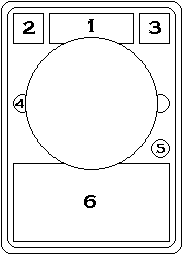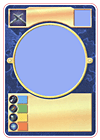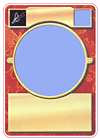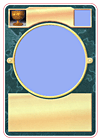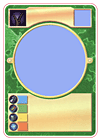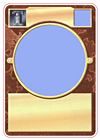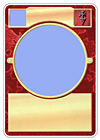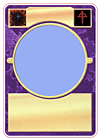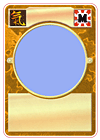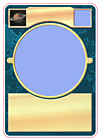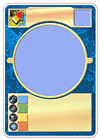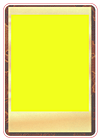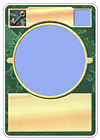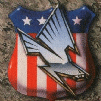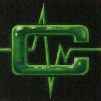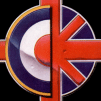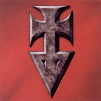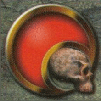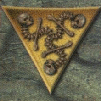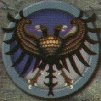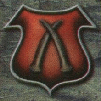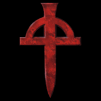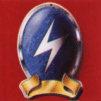 |
||||||||
DOOMTROOPER gENGINE EDITION RULESWHAT IS THE gENGINE EDITION? The following are the complete rules for the ultimate Domtrooper set, the gatlingEngine Edition! The gatlingEngine is a Windows application that lets you play collectible card games (CCGs) over the Internet with players from all over the world. The gatlingEngine is available at CCG Workshop and features many past and present CCGs. In fact, Doomtrooper was the gatlingEngine's first offering, and Doomtrooper players played a pivotal role in fine-tuning the program and the service. When players play Doomtrooper using the gatlingEngine, all cards and decks exist online, in a type of database. And because everyone has access to all the cards, and as many copies as they need, the confines of printed expansions and collectability and such are no longer in effect. This allowed the creation of a completely updated set of all the cards and the rules into one cohesive package. So that's what happened. Every card was updated to adhere to current standards, and many common effects were recategorized into new designations or keywords. Once the cards were complete (no small task) the rules were reorganized into a complete set incorporating all expansions. The following rules are designed specifically for the gEngine Edition. They assume you have never played Doomtrooper and will be using the gEngine cards available online via the gatlingEngine. These cards have not been printed, they are only available online. The gatlingEngine also allows you to play "Classic" Doomtrooper using the existing cards as they are printed and the 2nd Edition rules. To play, you will also need to set up a free account at CCG Workshop, download and install the latest version of the gatlingEngine, and set up the gEngine Edition of Doomtrooper. These rules do not go into those specifics. Enjoy! INTRODUCTION Then came the Great Exodus. The Earth, her soil fatally stained by the Corporations' years of environmental abuse, inevitably showed humanity the consequences of their indifference. Her riches and resources exhausted; the atmosphere gradually surrendered to the heavy pollution spewed out by the Corporate societies. New diseases emerged out of Mother Earth's womb. Viruses started to spread like wildfire, some more fatal or dangerous than others. All Corporations issued mandatory virus tests and people contaminated by the most heinous ones where stripped of their corporate affiliation and shipped like cattle in huge transport vessels to enormous underground quarantine bunkers in South America. In the end, South America was completely isolated and its civilization left to its destiny. This was not enough. The Corporate leaders, working together for the first time in centuries, enacted massive plans to save their people, and their livelihoods. Luna, Mars, Venus, even Mercury were terraformed to accept humanity. Enormous arks were constructed to carry the best and brightest to their new homes. Capitol ventured to the moon; Bauhaus tamed the wild jungles of Venus; Mishima fortified themselves within the soil of Mercury; Imperial, ever unwanted, sent their Conquistadors to every corner of the solar system, only to settle among the floating rocks of the Asteroid Belt. The brightest of humanity was saved. The vast rest of humanity were left on Earth, plagued by disease, ruin, famine and anarchy. The planet's climate and environment changed rapidly. The ozone layer, frayed and torn, yielded to strange greenhouse effects which twisted the Earth, as well as the beings left to suffer its desolate soil. Those who freed ourselves from the hell created on Earth discovered a new, more horrible threat. The weak and the poor fell victim to the Corporations, who rule the Solar System. Driven by their greed, the Corporations laid claim to the tenth planet and woke the sleeping beast, may its name be forever despised. Thus did the Dark Legion descend on us, howling for our death and destruction. Now is the time to conquer our fear and stand up against the tidal wave of the Dark Symmetry. NOW IS THE TIME FOR HEROES. Welcome to DOOMTROOPER! You are about to enter a distant future in which the hideous masses of the Dark Legion threaten to lay waste to the glory of humankind.
DOOMTROOPER is a card game perhaps unlike any card game you have ever played. Among the multitude of different cards available, you will find mighty heroes and horrible villains, deadly weapons and magical spells, desperate missions and wily schemes. The potential is endless because the possibilities are endless!
THE OBJECT If you enjoy longer or shorter games, simply adjust the number of Promotion Points needed to win the game. The choice is yours. However, we recommend that you try 25 Promotion Points as the goal for your first few games. Most experienced players play to 40 Promotion Points. NUMBER OF PLAYERS Multi-Player Games Option 1: Free for All. No restrictions. All players may freely attack all other players. This is the "classic" way to play DOOMTROOPER. Option 2: Primary Targets. Each player has one opponent as a Primary Target, and the other opponents are Secondary Targets. Your Primary Target is the player to your left. You may attack your Primary Target's warriors normally. You may attack the warriors of a Secondary Target, too, but you must first pay 2 Destiny Points each time you do. Option 3: Teams. If the number of players works out evenly, divide into teams. Each team starts the game with 10 Destiny Points in a common team pool, no matter how many players are on a team. Team members may only add to and draw from the points in their common team pool. Team members do not share Combat Areas or cards. The team that first acquires a pre-determined number of Promotion Points (say 50) wins the game. MARKERS THE TABLE LAYOUT You are allowed to put all types warriors into play. However, this is not a requirement. You may choose to play only Doomtroopers, or to field a force comprised of just Dark Legion warriors. An important consideration is that you always have a Squad, a Kohort and an Outpost, even if there are no warriors in them. That way all your Combat Areas may still be affected during the game.
Annihilated Pile Side Board Pile IMPORTANT: You may not look through ANY of your card piles during the game, unless a card allows it. Destiny Points Promotion Points THE PLAY OF THE GAME THE CARDS In all circumstances, if the rules on a card go against the rules in this manual, the rules on the card take precedence. The entire DOOMTROOPER set features twelve different Card Types. Almost all DOOMTROOPER cards have the same basic layout: DECK BUILDING 1) You must have at least 60 cards in your playing deck at the start of the game. 2) You must adhere to the Deck Limit listed on the card. You may not have more copies of the exact same card in your deck at the beginning of the game than the card's Deck Limit. 1) NAME - The name of the card or the thing it represents.
2) CARD TYPE ICON - Each of the twelve different card types has a unique design to give you a quick reference point. The card types are:
3) AFFILIATION ICON - Every card has an affiliation, which tells you from which major organization the card is associated. The affiliation of most cards have no effect on the game. The major exception is with warrior cards. The affiliation of a warrior is very important in that it tells you which other warriors that warrior may attack. Affiliation also tells the "origin" of the card, which may become important during the game. For example, an equipment card with the Bauhaus affiliation can also be called a piece of Bauhaus equipment. The complete DOOMTROOPER set features twelve different affiliations: 4) POST-PLAY ICON - After Art and Special cards are played, something must be done with them. Some remain in play, others are discarded, and a few are removed from the game entirely. Each Art and Special card has a small icon to the left of the picture which tells you what to do with the card after you play it (or once the effects of the card are completed). There are three such icons:
5) SET ICON - This small icon has no effect on the game. It merely denotes in which set or expansion the card was originally printed. It is included here for completeness and to help experienced "Classic" players find and organize cards. 6) CARD TEXT - The special abilities and restrictions of the card are listed here. Note that sometimes a designation will be listed on the card in ALL-CAPITAL letters. The purpose of some of these designations are discussed in this rulebook. Others will become apparent as you play the game. For Warrior, Beast and Warzone cards, the notes area includes four Combat Ratings. They are:
SETTING UP The gatlingEngine will do much of the setup for you, but not all of it. It is important to remember to shuffle your decks before you start. Then draw seven cards from the top of your draw pile to start your hand. When the game starts you will have five markers in your Destiny Point pool. These are your starting resources. THE CARDINAL'S GIFT A player that does have a warrior in his opening hand may also claim the Cardinal’s Gift, but in this case the first seven cards are not shuffled back into the playing deck. Instead, they become the first seven cards of the player’s discard pile. The Cardinal’s Gift may only be claimed after opening draw, and may only be claimed once by each player. THE ORDER OF PLAY
During your turn, you follow an order of play consisting of three steps. Some cards may only be played during certain steps (as noted directly on the card). When you're finished, it's your opponent's turn. The three steps are as follows:
1) Draw cards from your draw pile until your hand contains as many cards as your current Hand Limit.
2) Perform up to three actions. The actions that may be performed are:
3) Discard a single card if you wish.
STEP ONE: DRAW Draw cards from your draw pile to fill your hand to your Hand Limit. Your standard Hand Limit is 7 cards, but this can change via card play.This step is mandatory. If you draw the last card from your draw pile, continue playing normally. The game does not end; you simply have no more cards to draw (but see the No Warriors in Play and No Draw Pile rule below). If both players run out of cards from their draw piles, the game immediately ends, and the player with the higher number of Promotion Points wins the game. In the case of a tie, continue playing until one player has more Promotion Points than the other. Note that the Draw step is really broken into two phases. The "pre-draw" phase takes place between the time the draw step starts and the time that cards are actually drawn. During this time the current player may play Special cards that are "PLAY DURING YOUR TURN" and all players may play Special cards that are "PLAY AT ANY TME." Once all players have had a chance to play cards during the pre-draw phase, the current player draws cards. Drawing cards is considered an "instantaneous" event, and no cards may be played by any player while a player is drawing cards. As soon as the player draws his last card, the Actions Step begins. Special: If it is the first turn of the game, the first player does NOT get a Draw step. Instead, the first player's turn starts with his Actions step. TIMING AND ETIQUETTE STEP TWO: ACTIONS
You have three actions to perform during your turn. Actions may be taken in any order, and you may perform the same action more than once during your turn. There is one exception:
The two Tactical Actions (Sabotage and Attack) are special. You may only perform one Tactical Action per turn and must be the last action you perform. As soon as you perform a Tactical Action with one of your warriors, any unused actions are lost for that turn. You do not have to perform all three actions if you do not wish. You may even perform no actions at all. Also, several card effects will give you more actions to use during your turn, and even actions to use during other players' turns! Any unused actions are lost, and do not carry over to your next turn. The actions you may perform are as follows:
MEDITATE MUSTER WARRIOR To Muster a warrior, simply take the warrior from your hand and place it in its proper Combat Area, and then pay the Value of the warrior in Destiny Points to the common marker pile. If you do not have enough Destiny Points, you may not Muster that warrior.
Example: Mike has a Venusian Ranger (Value: 4) in his hand at the start of his turn and would like to put it into play. Mike announces that he is Mustering a warrior as his first action. He takes 4 Destiny Points from his pool and puts them in the common pile, then places the Ranger in his Squad. Mustering the warrior uses up one of his three actions, so Mike has two more actions.
Other Mustering Rules: • The Tribal affiliations hate each other, and will not work together. You may not Muster a warrior of one Tribal affiliation to your Outpost if there is already a warrior from another Tribal affiliation there. • A warrior may attack and be attacked in the same turn in which it is Mustered (except during your first turn). SEEK COVER • As long as you have one or more warriors in play, at least one of them must not be in cover. If one of your warriors is defeated in combat and discarded, and all your remaining warriors are in cover, you must perform an Exit Cover action on one of them as your next available action. • Warriors in cover may not attack, but they may be attacked. Warriors in cover receive a +3 bonus to their Armor ratings. • Wounded warriors may seek cover. They are flipped over like healthy warriors, but they remain sideways to indicate that they are wounded. (See the Attack action for information about wounded warriors). • You may look at your warriors in cover at any time, but other players may not. If you have more than one warrior in cover, you are not allowed to mix those warriors up to confuse the other players. EXIT COVER TANSFER WARRIOR • No Transfer actions may be made by any warrior until at least one warrior has entered play in an Outpost. Once any warrior enters play in any Outpost, Transfer actions may be taken. • Transferring costs one action, unless the Transferring warrior has or is considered a VEHICLE, in which case it costs two actions to Transfer. • A warrior may only voluntarily Transfer once per turn (from your Draw step to your next Draw step). It may Transfer more than once if "forced" to by Special card play. • You may not have both Doomtroopers and Dark Legion warriors in your Outpost at the same time. For example, you may not Transfer a Dark Legion warrior into an Outpost that contains at least one Doomtrooper. • If a Doomtrooper becomes a HERETIC which is still considered a Doomtrooper (like through the Tainted card) then it may be in an Outpost with other Doomtroopers (and it may even be in an Outpost with Dark Legion warriors). But if a Doomtrooper in an Outpost is fully turned into a Dark Legion minion (like through the Dark Visitation card) and other Doomtroopers are in the Outpost, then for your next available action you must transfer it to your Kohort. • TRIBAL warriors have no such affiliation restrictions. Doomtroopers and Tribal warriors may work together, as may TRIBAL warriors and Dark Legion warriors. • If your spies detect possible enemy movement on Earth, you must go check it out. Therefore, if any opponent has a warrior in his or her Outpost (of any affiliation), you must Transfer at least one warrior to your Outpost during your next regular action. As long as there are warriors in an Outpost, all players must have a warrior in his or her Outpost. EQUIP WARRIOR • A warrior may be equipped with any number of Equipment or Relic cards.All Relic cards are unique; you may never play a Relic card if there already is an identical Relic card in play. Copies of discarded Relics may enter play again later. • Any warrior may use any Equipment or Relic, regardless of affiliation, unless it is specified otherwise in the notes on the card. For instance, Dark Legion warriors are allowed to use Brotherhood weapons. But if the weapon card states "Give to any Doomtrooper," then only Doomtroopers may use the weapon, and not Dark Legion warriors. • Once you place an Equipment or Relic card on a warrior, that card becomes attached to the warrior and may not be removed or moved to another warrior, except via card play. • You may give a warrior any number of Equipment cards, but it may only use one of each copy at a time. You may give warriors multiple copies of the same Equipment card as backups in case something happens to one of them - these backups may be used immediately if needed. • All Relic cards are unique; you may never play a Relic card if there already is an identical Relic card anywhere in play. Copies of discarded Relics may enter play again later. • Some Equipment and Relic cards have further designations such as WEAPON, ARMOR or VEHICLE. These designations affect the card in special ways: WEAPONS - The only things that are considered "weapons" are cards that specifically say FIGHT WEAPON, SHOOT WEAPON, FIGHT/SHOOT WEAPON or SPECIAL WEAPON on them. Of course, in "real" terms many other pieces of equipment are obviously weapons, but in game terms it has to say so right on the card. A warrior may only use one WEAPON during combat (it may have several). ARMOR - A card designated as ARMOR provides a suit of protection to the warrior. Unlike most other Equipment cards, a warrior may only have one piece of ARMOR. VEHICLES • A warrior may only gain the benefits of a VEHICLE when it is inside the VEHICLE. • Sometimes (but not always) a VEHICLE restricts the use of other Equipment or Relics while it is being used. If a VEHICLE does not say that it restricts Equipment or Relics, then they may be used. Often this restriction is in the form of WEAPONS. If the VEHICLE restricts Equipment, it restricts all Equipment cards (it does not restrict Relics); if it restricts WEAPONS, then only WEAPONS are restricted, and ARMOR and other cards may be used, etc. • If the warrior is outside the VEHICLE, it may use other equipment with no restrictions. The warrior is still considered to have possession of the Vehicle. • If the warrior is inside its VEHICLE and the VEHICLE is discarded, the warrior is wounded (no points are earned if the warrior is killed). If the warrior is outside its VEHICLE and the VEHICLE is discarded, the warrior is not affected. • If the warrior is inside the VEHICLE, the following things are enforced: • A warrior inside an AIRSHIP or a SUBMARINE may not attack or be attacked by another warrior with a Fight combat. If a warrior with an AIRSHIP or SUBMARINE wishes to attack another by Fighting, it must first exit the AIRSHIP or SUBMARINE. Generic VEHICLES and TANKS are not affected in this way. VEHICLES - Vehicles are very specialized pieces of equipment that have a unique set of rules all their own (found in the Notes From the Masters to the right). Like ARMOR, a warrior may only have one VEHICLE. A warrior with a VEHICLE must be either Inside or Outside of its Vehicle. When a warrior is first equipped with a vehicle, the player must announce if the warrior is inside or outside the VEHICLE. To signify that a warrior is outside a VEHICLE (thereby unable to use it or gain its effects), place the VEHICLE face-down on the table next to the warrior. To signify that a warrior is inside a VEHICLE, place the VEHICLE face-up on the table next to the warrior. If you choose to have the warrior initially outside the VEHICLE, you must still show it to your opponents. An important thing to remember is that since warriors in cover are not allowed to be in Vehicles, if you give a Vehicle to a warrior in cover it must be outside (and you still must show it to your opponents, as noted above, even if the warrior itself has not yet revealed). ENTER/EXIT VEHICLE • Placing the warrior initially inside the Vehicle does not cost an action. • A warrior with the VEHICLE designation or "Considered a VEHICLE" is always assumed to be inside, and may never exit. WRANGLE BEAST • You may give a Beast to a warrior that may have it as one action. • A warrior may only be given a Beast if the warrior is in your Outpost. • A warrior may have either one Beast or one VEHICLE. It may not have more than one Beast or VEHICLE, and may not have a Beast and a VEHICLE. It may have other Equipment and Relics as normal. • Unlike VEHICLES, when you give a warrior a Beast it is assumed that the warrior is always riding the Beast. A warrior must always use its Beast during combat. • The Beast card features modifiers to F, S, A and V that are applied to the warrior that is riding the Beast. These modifiers are applied to the base ratings of the warrior before all other modifiers. In effect, they create new base ratings. • A warrior with a Beast may not voluntarily Transfer out of the Outpost while the Beast is attached. If the warrior is "forced" to leave the Outpost through card play, the Beast is discarded (unless the warrior is moved to another Outpost). • A warrior with a Beast may gain the effects from Fortifications, and may be in cover. • Warriors with the BEAST designation or "Considered BEASTS" may not have Beasts or VEHICLES, may not Transfer, and are discarded if forced out of an Outpost. They may gain the effects of Fortifications, and may be in Cover. BUILD FORTIFICATION BESTOW DARK SYMMETRY GIFT There are three levels of gift:
BESTOW KI POWER Ki Powers may also be given to warriors who gain the Mishima affiliation through card play. If a warrior loses his Mishima affiliation he may keep his Ki Powers, but no more may be attached until he regains his Mishima affiliation. ASSIGN MISSION
Players and warriors may have any number of different missions assigned to them, but you may not assign multiples of the same mission to the same player or warrior. Once a mission is fulfilled, you may then assign another copy of the same mission to the player or warrior. Finally, fulfilling the parameters of a mission is always optional. However, if a player or warrior does fulfill the parameters of an assigned mission, that mission must be fulfilled. You can't keep the mission in play and disregard the original fulfillment.
PROCLAIM ALLIANCE ESTABLISH WARZONE SABOTAGE (TACTICAL ACTION) • Your sabotaging warrior must be able to participate in combat (NONCOMBATANTS may not Sabotage). • You may only sabotage each player once per turn (from your Draw step to your next Draw step). Even if you gain more Tactical Actions, you may not Sabotage more than once per turn (however, see the Multiple Sabotages optional rule, below). • To perform a sabotage, simply announce which of your warriors will perform the sabotage. Unless the player can play a card which will prevent the action, the sabotage will be successful. As a reward, you earn a number of points equal to one-half the modified Value (V) of your sabotaging warrior (rounded up). You may take Promotion Points, Destiny Points, or a combination of both. • You may never perform a sabotage action until all players have taken at least one turn. You may never perform a sabotage action during another player's turn. If you become able to perform T-Actions when it is not your turn, none may ever be sabotage actions. Optional Rule: Multiple Sabotages ATTACK (TACTICAL ACTION) Because attacking is a Tactical Action, you may normally only perform one attack action per turn, and this action must be the last action you perform. If you attack as your first or second action, you lose any actions you did not use. Also, you may not attack during your first turn of the game.
When you perform an attack action, one of your warriors may attack almost any other warrior in play. Combat is usually between one attacking warrior (the Attacker) and one defending warrior (the Defender). Various cards may allow additional warriors to join in the battle.
It is possible (through card play) that you may be able to perform more than one attack action during a turn. If this is the case, you may attack with the same warrior more than once, and you may attack the same warrior more than once (this is always optional). The only thing to remember is that each attack action must be conducted completely separately of any other. You must conduct an entire action before going on to the next.
Combat is a very straightforward affair, and it is broken down into a number of simple steps. First, you (as the attacking player) choose an Attacker and a Defender. Then you decide if the combat will be a Fighting combat or a Shooting combat (this is called the Battle Tactic) and the Defender decides in which Warzone the combat will take place (if any). Next, compare the combatants' attack ratings with their Armor ratings to see how the attack is going. Both players may then play cards to modify the combat ratings of the warriors involved in the combat. Then the final, modified combat ratings are compared.
Any warrior that has been hit is turned sideways to indicate that it is wounded. If a wounded warrior is hit, it is killed and discarded. A dead warrior is worth a number of points equal to the slain warrior's modified Value. These points are awarded to the player whose warrior made the killing blow. They may be converted into Promotion Points or Destiny Points (or a combination of both).
The steps for combat are as follows: 1) ANNOUNCE ATTACKER AND DEFENDER. You (as the attacking player) choose one of your warriors in play as the Attacker and pick another warrior in play to attack (this is the Defender). No matter the outcome of the battle, the two warriors are referred to as the Attacker and the Defender throughout the combat. There are a couple of rules to keep in mind when choosing the Attacker and Defender: • No Doomtrooper may attack another Doomtrooper from the same corporation. If a warrior shares any type of corporate membership with another, it may not be attacked. For example, Bauhaus warriors may not attack other Bauhaus warriors, but Bauhaus warriors may attack Capitol warriors. • A Doomtrooper may never attack a member of the Brotherhood. • Brotherhood members may only attack Dark Legion and Tribal warriors. • Dark Legion warriors may attack any other warrior in play, even other Dark Legion warriors. • Warriors in your Outpost may only attack warriors in other Outposts. They may never attack warriors in Squads or Kohorts. Likewise, warriors in Squads and Kohorts may never attack warriors in Outposts. Even if a card is played that may change the Attacker or Defender of a combat to any other warrior in play you may not break this rule! • The warriors of the various TRIBAL affiliations may attack and be attacked by any other warrior, regardless of affiliation, even other like-affiliated warriors (for example, Templars may attack other Templars). • A warrior designated as an ASSASSIN may attack any warrior in play, regardless of affiliation (note that other warriors are still held by their affiliation restrictions when attacking them). • Any warrior designated as a NONCOMBATANT may never attack or be the target of an attack. Even if you play a card effect that lets you change an Attacker or Defender to "any warrior in play" you may not use it on a NONCOMBATANTS. You will have to figure out other ways to get NONCOMBATANTS out of the game. • Your warriors may not attack your own warriors. However you may "force" your warriors to attack your warriors (through Special card play or Art spells, etc.). 2) ANNOUNCE BATTLE TACTICS. You must now announce which type of Battle Tactic the Attacker will use. This determines which attack rating and which weapons, equipment and modifiers the Attacker and Defender may use during the combat. Each warrior has two attack ratings, Fight and Shoot. The Attacker may charge the Defender with fist and sword, which is a close combat (in which case both warriors use their Fight ratings), or it may attack with guns blazing, which is a firearm combat (in which case both warriors use their Shoot ratings). 3) ANNOUNCE WARZONE. The Defending player announces if his warrior will defend from a Warzone, and which one. Only a Warzone that is in the same Combat Area as the Defender may be chosen. • The Defender (and only the Defender) gains the F, S A and V modifiers listed on the Warzone card, but all combatants are affected by the text on the card. • If you defend from a Warzone, *neither combatant may use effects from Fortification cards. Equipment and warriors with the FORTIFICATION designation or "considered FORTIFICATIONS" may be used. • When attacking, you may not use your Warzones. • The warriors in a Combat Area may not use the Warzones in your other Combat Areas. 4) DETERMINE COMBAT STANDING. Look at the rating of your warrior's chosen attack method and compare it to the Armor rating of the opponent. If the attack rating of a warrior is equal to or greater than the Armor rating of its opponent, the opponent will be wounded. The Defender simultaneously makes an attack of its own. Check to see how that attack is going, too. Example: Nick is performing an attack action. He announces that Sean Gallagher (an Imperial Doomtrooper) will Fight Mike's Nepharite of Ilian (a Dark Legion warrior). Sean has a Fight rating of 10, a Shoot rating of 5, and an Armor rating of 8. The Nepharite has a Fight rating of 8, a Shoot rating of 8, and an Armor rating of 7. Since this is a close combat, only the Fight and Armor ratings are used. Because Sean and the Nepharite are striking at each other at the same time, both warriors compare both ratings. Sean attacks with a Fight rating of 10 against the Nepharite's Armor rating of 7. Because 10 is higher than 7, the Nepharite is well on its way to being wounded. The Nepharite strikes at Gallagher with a Fight rating of 8 against Sean's Armor rating of 8. Since 8 is equal to 8, the Nepharite will also wound Sean.
Be sure to include the effects of equipment cards that each warrior has, but only if they have an effect in the chosen method of combat. A warrior may only use one WEAPON during combat, but may use any number of other equipment cards that apply (but only one of each copy). Only FIGHT WEAPONS may be used in Fight combats, just as SHOOT WEAPONS may only be used in Shoot combats. FIGHT/ SHOOT WEAPONS may be used in either. For instance, a Violator Sword (a FIGHT WEAPON) has no effect in a shooting combat. A wounded warrior (see below) battles as normal. If the Defender is in cover (its card is face down), it adds +3 to its Armor rating. A Defender in cover stays in cover throughout and after the combat, assuming it survives. Turn it face up for the combat, then turn it face down again afterwards. Keep in mind that neither warrior has actually been wounded yet. You're just checking to see how the combat is coming along. 5) MODIFY COMBAT RATINGS. Starting with you (the attacking player), players take turns playing cards which have an effect on combat. Such cards have "PLAY DURING COMBAT," or a variation thereof, printed on them. Play as many cards as you like, and then indicate that you're finished. Your opponent then plays as many modifying cards as he wishes, and then indicates that he is finished. Then other players may play cards. You may then play additional cards, and so on, until no player wishes to play any more cards. A player may play multiple copies of modifier cards on a warrior during this step, and their effects are cumulative when applicable. Some cards allow players to change the Attacker or Defender involved in a combat. When this occurs, the player(s) in control of the new Attacker or Defender may play cards to modify the new warriors' ratings normally Sometimes various special cards or other effects may cause combat ratings to drop to zero or lower. Negative numbers still count. For example, a warrior with a modified Fight rating of -4 will still wound an opponent with a modified Armor of -4 or less. However, a warrior's Value stat (V) may never be lower than 0. Modified V stats of less than 0 are considered to be 0. 6) RESOLVE COMBAT. Once all modifiers are taken into account, compare the warriors' combat values one last time and determine if either or both warriors are wounded. If the modified attack rating against a warrior is equal to or greater than the warrior's modified Armor rating, that warrior is wounded. If the modified attack rating is lower than the Armor rating, the warrior resists all of the potential damage. A warrior is either wounded by an attack or not affected at all. There is no middle ground, and damage does not "carry over" from combat to combat. 7) CHANGE WARRIOR STATUS. Warriors wounded in the battle are turned 90 degrees sideways to indicate that they are wounded. A wounded warrior is completely unaffected by the wound. Its combat ratings are not affected, nor are any of its abilities or equipment. The wounded warrior attacks and defends as normal. However, if a wounded warrior is wounded again, it is killed. 8) AWARD POINTS. If a warrior's opponent is killed, the warrior's controlling player is awarded a number of points equal to the modified Value of the slain opponent (even if the player's warrior was slain, too). If both warriors are killed, both players earn points. The points may be taken as Promotion Points or placed in your pool as Destiny Points, or they may be split between the two types as you like. In the event that your warrior ends up in combat against another of your warriors, and either or both of your warriors is killed, you only earn Destiny Points. You never get Promotion Points for killing your own warriors, even if forced to by your opponents. STEP THREE: DISCARD
You may discard one card from your hand to your discard pile (no matter how many cards are in your hand). This ends your turn. Remember that a player's discarded and annihilated cards are placed face down, and no player may look through their own or others' discard piles! You do not have to reveal which card you discarded. Like the Draw step, the Discard step is broken into two phases. The "pre-discard" phase takes place between the time the Actions step ends and the time that a card is actually discarded. During this time the current player may play Special cards that are "PLAY DURING YOUR TURN" and all players may play Special cards that are "PLAY AT ANY TME." Once all players have had a chance to play cards during the pre-discard phase, the current player may discard a card, or announce that no card will be discarded. Discarding a card is considered an "instantaneous" event, and no cards may be played by any player while a player is discarding. As soon as the player discards, the player's turn ends, and the next player's Draw step begins. OTHER RULES NO WARRIORS IN PLAY AND NO DRAW PILE An important point to remember is that any warrior able to participate in combat meets this requirement. Even if your warriors are not able to attack your opponent's warriors (due to the attack restrictions listed above), they are still able to participate in combat (they can attack and be attacked in some way). CASTING SPELLS OF THE ART Many Art spells have a casting cost in Destiny Points. The more Destiny Points you spend, the more powerful the spell's effects. Unless a limit is indicated on the card, you may spend as many Destiny Points as you have. If such a spell is cast during combat, you may continue to add Destiny Points to the spell throughout the Combat Modification step. Art cards designated as a COMBAT SPELL or PERSONAL COMBAT SPELL may only be cast during combat. A COMBAT SPELL may be cast on any combatant, and the caster does not have to be involved in combat. PERSONAL COMBAT SPELLS may only be cast if the caster is actually involved in the combat, either as an Attacker, a Defender or a reinforcement. Art spells may be cast by a warrior in cover. Art cards may not normally be played to the benefit of the Dark Legion. You may not, for instance, cast Art spells to assist your Dark Legion warrior in combat. Remember, the sworn duty of the Brotherhood is to eradicate the Dark Legion, not help them in their nefarious goals! However, if is possible for a spellcaster to be "tainted" and turned to the side of evil. The basic thing to remember is, if the Brother is pure of heart, it may only cast spells on Doomtroopers. If it is "tainted" and is considered both a Doomtrooper and a Dark Legion Heretic, then it may cast spells on all warriors. If it has been turned into a full-blown Heretic and no longer has Doomtrooper-affiliation, it may only cast spells for the Dark Legion. Any warrior able to cast Art spells may cast them to the benefit and disadvantage of Tribal warriors. DESIGNATIONS Some cards contain designations in their initial card texts. These keywords are usually in ALL CAPITAL letters, and provide the card with added identity or capability. Some will simply list the designation, others will state CONSIDERED A [DESIGNATION] on them. Several of these designations are defined here. Others are found only on the cards and you will have to discover for yourself their overall effects and interactions. An important thing to remember is that each card's title is also a designation. For example, the Infantry warrior card is assumed to have the INFANTRY designation. Also, whenever a warrior is considered a different kind of warrior, it is in name only. Special abilities and such do not transfer over. For example, Mitch Hunter has the INFANTRY designation. This means that Mitch is affected by cards that affect INFANTRY warriors, but it does not mean that Mitch Hunter gains any special abilities listed on the actual Infantry card. Those abilities do not magically "transfer" to the other card! In other words, a card only has the abilities written on its card, plus any abilities specifically provided by other cards. Several designations are described above (such as VEHICLE and SHOOT WEAPON). Here is a listing of some more common designations, and their effects in the game: BLESSED FIRST STRIKE/STRIKE FIRST Some warriors with FIRST STRIKE specifically state that the combat ends if successful with their attacks. In this case, the opponent may not strike back even if it survives. If two warriors with the FIRST STRIKE ability combat each other, their abilities negate one another and the combat is resolved as normal. Note, however, that some warriors are able to STRIKE FIRST even if their opponent also has the ability. This will all be stated on the warrior cards. FREELANCER If a FREELANCER gains a specific affiliation (through card play) it is no longer considered a FREELANCER, and that designation is no longer in effect. It may earn Promotion Points while it has the affiliation. However, it must also adhere to the rules for attacking based on this new affiliation. Therefore, a FREELANCER that is given the Imperial affiliation may not attack or be attacked by Imperial and Brotherhood warriors. If the warrior then loses these affiliations, it reverts to being a FREELANCER again. IMMUNITY A warrior who is immune to something is not affected by that thing if it can interact with the warrior in any way. No spells may be cast during combat if the opponent ihas ART IMMUNITY, and no Dark Symmetry abilities may be used if the opponent COMPLETE SYMMETRY IMMUNITY (but if the warrior only has MINOR SYMMETRY IMMUNITY, it is still affected by MAJOR GIFTS). No spells or special abilities may be directly used against immune warriors (this is all usually very obvious). Important: Immunity negates all such effects during combat. Basically, if during combat one of the combatants is immune to a mystical power, all of those effects that are currently "on" immediately "turn off." This usually only applies with "defensive" spells. For example, suppose Mike casts Improve Self on his Brotherhood warrior and then attacks Nick's Alakhai the Cunning. Nick's Dark Legion warrior will counter Mike's Improve Self effects. Also important: Warriors who are immune to cards MAY STILL HAVE AND USE those cards. They are just not affected by those card effects. So a warrior who has ART IMMUNITY cay cast Art spells (even ones that target the caster), but none affect the caster. A warrior who has COMPLETE SYMMETRY IMMUNITY may still be bestowed with Gifts (even ones that would affect the warrior) but they do not affect the warrior. PERSONALITY If a PERSONALITY is killed or discarded, it may be brought back into play later in the game as normal (being great heroes, PERSONALITY have a knack for staying alive). In fact, the same warrior may be killed a number of times during a game and still come back for more. PROFANE SERGEANT • Only warriors with base Values LOWER THAN the base Value of the SERGEANT may be assigned to the Sergeant. This means that the only numbers you compare are the Values printed on the warrior cards. Do NOT take V modifiers into account, even if the modified V of the assigned warrior is equal to or higher than its Sergeant. The reason is that Value is not equivalent to “rank”, it is a measure of the individual’s worth on the battlefield. As everyone knows, the lowliest private may be more worthwhile than any high-ranking goon in the thick of battle! This leads to a few assumptions: • A warrior card group (for example, the SEA LIONS, the CLANSMEN, the FREE MARINES, the BAUHAUS BLITZERS, etc.) may only have one SERGEANT assigned to it. • If a warrior group’s SERGEANTS is killed, they may have another SERGEANTS assigned to it. • If the last of the assigned warrior group is killed, the SERGEANTS may be re-assigned to a different warrior group. • Once a SERGEANTS is assigned to a warrior group, the assignment is permanent while both the group members and the SERGEANTS are in play. • You do NOT have to assign the SERGEANTS to a warrior group when he is played. You may assign the SERGEANTS at any time (even during combat). Once assigned, the SERGEANTS is stuck with that group, and they are stuck with him! • If the SERGEANTS loses it’s Corporate affiliation, the assignment is broken. Likewise, if the last of the assigned warriors loses its affiliation, the assignment is broken. Remember that many times when a Corporate warrior is turned into a HERETIC, he still keeps his Corporate affiliation (he becomes a spy!). SLAYER THAT'S ALL, FOLKS!
|

